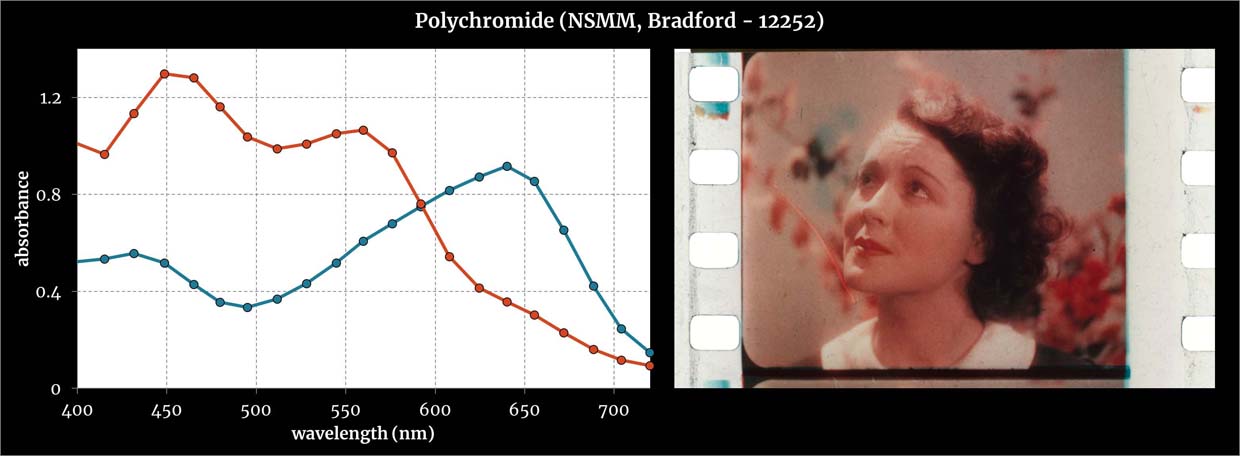Polychromide
Description
“Polychromide, a two-color subtractive process invented in 1918 by Aron Hamburger, achieved limited commercial success overseas, and was occasionally employed in England as late as 1933. Originally an orthochromatic and a panchromatic negative were exposed in a beamsplitter camera. Later the use of the beam-splitter was dropped in favor of a conventional camera using bipack negative films. Polychromide prints were made on double-coated positive film stock which was dye toned red-orange on one side and blue-green on the other. Exposure from each of the camera negatives was made simultaneously by the printer on opposite sides of the positive film. Perhaps the most significant advancements made by Hamburger lay in his dye-mordanting process. He was probably the first to dye the film first and to bleach and mordant afterward. This alteration of standard procedure resulted in improved color consistency throughout the length of the film.
Although Hamburger was an American by birth, he developed his system in England and no record of its commercial use in the United States could be found.”
(Nowotny, Robert A. (1983): The Way of All Flesh Tones. A History of Color Motion Picture Processes, 1895-1929. New York: Garland Pub, pp. 132-133.)
-
![]()
Polychromide samples from the Kodak Film Samples Collection at the National Science and Media Museum in Bradford.
Credit: National Science and Media Museum Bradford.
Photographs by Barbara Flueckiger in collaboration with Noemi Daugaard.
-
![]()
Credit: Brian Pritchard
-
![]()
Source: Pénichon, Sylvie (2013): Twentieth Century Colour Photographs. The Complete Guide to Processes, Identification & Preservation. London, Los Angeles: Thames & Hudson, p. 279.
Galleries Open all Galleries ▼
Secondary Sources
Brown, Simon (2012): Technical Appendix. In: Sarah Street: Colour Films in Britain. The Negotiation of Innovation 1900-55. Basingstoke, Hampshire: Palgrave Macmillan, pp. 259-287, on p. 278. View Quote
Cherchi Usai, Paolo (2000): Silent Cinema. London: BFI, p. 36. View Quote
Cleveland, David; Pritchard, Brian (2015): How Films were Made and Shown. Some Aspects of the Technical Side of Motion Picture Film 1895-2015. Manningtree, Essex: David Cleveland, on p. 210. View Quote
Coe, Brian (1981): The History of Movie Photography. Westfield, N.J.: Eastview Editions, p. 128. View Quote
Evans, Ralph Merrill; Hanson, W.T., Jr.; Brewer, W. Lyle (1953): Principles of Color Photography. New York: Wiley, p. 296. View Quote
Klein, Adrian Bernhard = Cornwell-Clyne (1940): Colour Cinematography. Boston: American Photographic Pub. Co., 2nd revised edition, pp. 207-209. View Quote
Koshofer, Gert (1981): Geschichte der Farbverfahren in der Spezialistenzeit. In: Joseph-Haubrich-Kunsthalle and Agfa-Gevaert Foto-Historama Leverkusen (eds.): Farbe im Photo. Die Geschichte der Farbenphotographie von 1861 bis 1981. Katalogbuch. Köln: Joseph-Haubrich-Kunsthalle, p. 101. View Quote
Koshofer, Gert (1996): Early Colorfilm Processes for the Cinema. In: Monica Dall’Asta, Guglielmo Pescatore and Leonardo Quaresima (eds.): Il colore nel cinema muto. Bologna: Clueb, pp. 43-44. View Quote
Nowotny, Robert A. (1983): The Way of All Flesh Tones. A History of Color Motion Picture Processes, 1895-1929. New York: Garland Pub, pp. 132-133. View Quote
Pénichon, Sylvie (2013): Twentieth Century Colour Photographs. The Complete Guide to Processes, Identification & Preservation. London, Los Angeles: Thames & Hudson, on pp. 278–279. View Quote
Ryan, Roderick T. (1977): A History of Motion Picture Color Technology. London: Focal Press, pp 75-77. View Quote
Measurements

Absorbances measured with a multispectral imaging system from film areas with pure dyes. Credit: Giorgio Trumpy, ERC Advanced Grant FilmColors.
See the specific sample from which the spectra were measured.
Films
According to Brown, Simon (2012): Technical Appendix: Polychromide/Verachrome. In: Street, Sarah: Colour films in Britain. The Negotiation of Innovation 1900-55. Basingstoke, Hampshire: Palgrave Macmillan, p. 278:
The BFI National Archive holds a compilation from 1926 entitled ‘Selections Illustrating the British Polychromide Colour Process’ which includes the 1927 film of the eclipse.
How I Play Tennis by Mile Suzanne Lenglen (1925)
Downloads
Patents
E.P. 20,880 (Hamburger, Aron; filed Sept. 21, 1911; granted Sept. 23, 1912)
Download PDFE.P. 28,722 (Conrady, Alexander Eugen/Hamburger, Aron; filed Dec. 13, 1912; granted Dec. 15, 1913)
Download PDFE.P. 123,786 (Hamburger, Aron; filed Dec. 3, 1917; granted Mar. 3, 1919)
Download PDFE.P. 123,787 (Hamburger, Aron; filed Dec. 3, 1917; granted Mar. 3, 1919)
Download PDFE.P. 136,595 (Day, Wilfred Ernest Lytton/Hamburger, Aron; filed Nov. 14, 1918; granted Dec. 15, 1919)
Download PDFE.P. 203,358 (Hamburger, Aron; filed Mar. 7, 1922; granted Sept. 7, 1923)
Download PDFE.P. 237,941 (Coston, Herbert Ernest/Hamburger, Aron; filed Dec. 22, 1924; granted Aug. 13, 1925)
Download PDFE.P. 261,054 (Coston, Herbert Ernest; filed May 12, 1925; granted Nov. 12, 1926)
Download PDF
Contemporary Reception
Anonymous (1928): Doubts on Colour. In: The Bioscope, 1151,LXXVII, Oct., p. 28. View Quote
Anonymous (1928): Polychromide Process Demonstrated. Two Negatives and Double-Sided Positive. In: The Bioscope, 1151,LXXVII, Oct., p. 23. View Quote
Anonymous (1928): The Polychromide Colour Process. In: The Bioscope, 1151,LXXVII, Oct., p. x. View Quote






